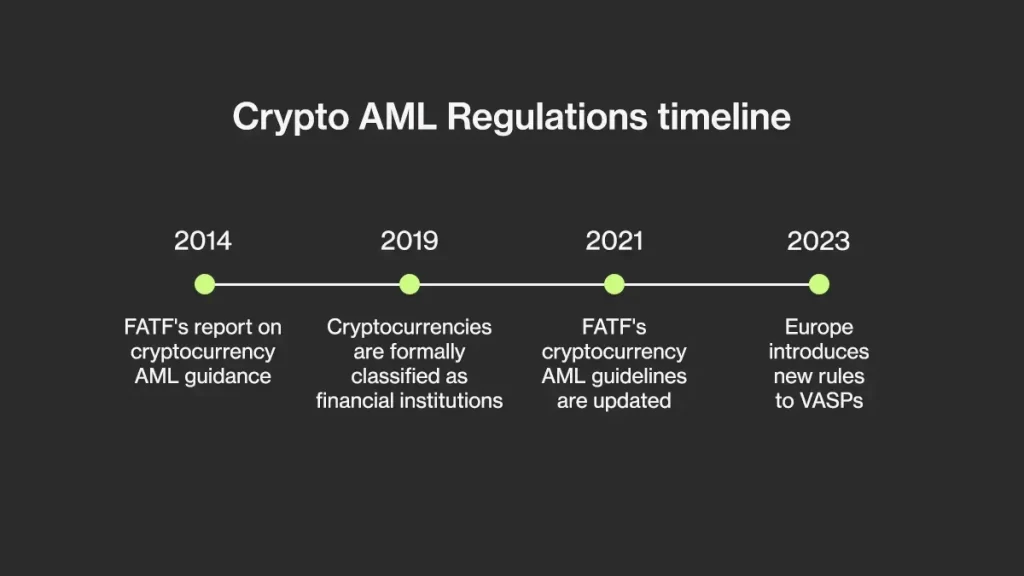For years, the crypto market operated without any official laws aimed at it. This allowed crypto to grow quickly as crypto exchanges did not need to worry about the same regulations that other financial institutions did. However, it left them vulnerable to fraudsters and money laundering. In 2019, this changed when cryptocurrency exchanges were formally classified as financial institutions. In this article, we will look into how this affected the crypto market.
Why does Crypto Include a Higher Risk of Money Laundering?
In June 2014, the Financial Action Task Force (FATF) released a report that highlighted the following concerns for cryptocurrencies:
Anonymity
Cryptocurrency attracts many users due to its anonymity. Crypto allows users to trade virtual currency on the internet, and transactions are generally performed without face-to-face interaction. This allows for anonymous funding without adequately identifying the funding source.
International transactions
AML risks are made greater by worldwide reach as it makes surveillance and enforcement more difficult.
No centralized oversight
Due to the fundamental nature of crypto, law enforcement cannot conduct an investigation or seize assets against a single central location or entity. Thus, virtual currency transactions provide a level of anonymity that is not possible with traditional payment methods and therefore make it harder to trace criminal activity back to the culprits.
Crypto AML Regulations Timeline

Although crypto is one of the newer forms of payments, it has already undergone quite a few big changes. Let’s take a look at it here:
2014
The FATF publishes a report on cryptocurrency AML guidance. As a result, policymakers in FATF member jurisdictions legally codify most of FATF’s cryptocurrency AML recommendations.
2019
Three financial regulators — the Commodity Futures Trading Commission, Securities and Exchange Commission, and FinCEN — issue a joint statement formally classifying cryptocurrency exchanges as financial institutions in the US. This makes the crypto market subject to anti-money-laundering (AML) rules established by the Bank Secrecy Act. The statement ushered in an era of renewed regulatory thrust directed at cryptocurrency exchanges.
2021
The FATF updates its cryptocurrency AML guidance, clarifying the definitions of virtual assets, how the guidance rules apply to stablecoins, and defines Virtual Asset Service providers (VASPs).
2023
Europe introduces new rules for VASPs, making the collection and reporting of certain data about the sender and beneficiary necessary regardless of the amount of crypto assets being transferred. This makes crypto transfers easier to identify in the case of suspicious transactions.
Crypto AML Regulations
Due to the inherent anonymity of cryptocurrency, it poses a higher risk for potential money laundering. To counter this risk and ensure compliance with Anti-Money Laundering (AML) requirements established by the Bank Secrecy Act, the following steps should be implemented in the crypto market:
- Implement a risk-based approach, thoroughly assessing and prioritizing potential money laundering and financial crime risks. Regularly update these assessments to align with evolving regulatory requirements.
- Utilize AML screening procedures, such as Know Your Customer (KYC) processes, Customer Due Diligence (CDD) checks, and screening services for sanctions, politically exposed persons (PEPs), and adverse media. These measures help verify user identities and detect suspicious activities.
- Stay informed about changes in regulatory frameworks, keeping abreast of the latest developments in the crypto industry. Engage in horizon scanning to anticipate upcoming changes and allocate necessary resources for compliance.
- Monitor and adapt to jurisdiction-specific regulations, as different regions may have varying perspectives on crypto regulations. Stay informed about specific nuances and considerations applicable to your operations in different areas.
- Embrace technological solutions to enhance compliance efforts. Leverage advancements in technology, such as artificial intelligence-supported compliance tools like Sanction Scanner, to streamline compliance processes and effectively detect and prevent financial crimes.
Ondato’s KYC Solution for Crypto
To help VASPs achieve the highest level of AML compliance, Ondato offers many benefits.
Enhanced Client Trust
Implementing KYC can significantly enhance your company’s credibility and transparency in the eyes of your customers. By verifying client identities, you provide an additional layer of security that effectively thwarts account takeovers.
Prevention of Fraud
KYC acts as a powerful deterrent against scammers and financial criminals attempting to exploit your platform. Cryptocurrency platforms are prime targets for money launderers, resulting in a 30% increase in laundering attempts compared to the previous year.
Improved Image of the Crypto Industry
The cryptocurrency market has long been associated with instability and a prevalence of illicit activities. However, incorporating robust KYC and AML procedures can gradually transform the market’s reputation and attract new customers.
Last thoughts
As crypto is a fast evolving market, it is subject to many regulatory changes. It is important that VASPs are prepared to handle these changes when they come. It is also important to note that because of the high risk of AML in the market, cryptocurrency services should invest in the highest level of compliance. This can be done with the help of Ondato.



